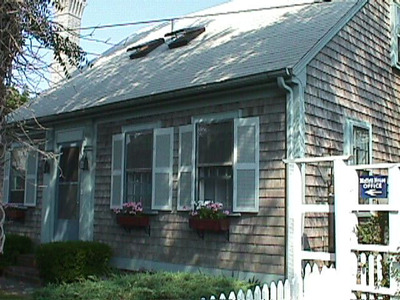296A Commercial St
Historic District Survey information for 296A Commercial St | |
Architectural Description: 296A Commercial St. is a 1-1/2-story, 3-bay, Colonial Revival-style, 3/4 cottage; side-gable roof is sheathed in asphalt shingles, skylights; exterior clad in wood shingles with wood corner boards and trim; building sits on a brick foundation; fenestration includes 12/12 wood DHS windows with storms and wood trim, 6/6 wood DHS on right side facade, inoperable louvered shutters; primary entrance has a wood door surround with pilasters and dentil-like trim; brick stoop and patio; secondary entrance on right side facade; rear addition with irregular roof is lit by 6/6 wood DHS and 4/4 wood DHS. |
|
Historical Narrative: As per Josephine Del Deo (1977): "The home of Ross and Dorothy Lake Gregory Moffett was used by tem for over fifty years as a residence and painting studio. Although Moffett painted in several other locations until 1964, his wife used the premises for her work as a painter and illustrator during most of the period from 1933 to 1975. Ross Moffett was one of the deans of American painting and lived in Provincetown from 1913 to his death in 1971. He was one of there very important painters to come out of the period of painting pre-eminence here from 1915-1960. The other two, Edwin Dickinson and Karl Knaths were his contemporaries, and Dickinson, also a Hawthorne student, was his closest friend. The group of painters just prior to Moffett clustered around Charles W. Hawthorne as the leader in that movement. Knaths and Moffett lived all their lives from 1920-1971 in Provincetown (See No. 8-P)
In addition to his contribution as a painter, Moffett was a local historian (see bibliography below) and an amateur archaeologist. He wrote many treatise of his archaeological finding on the Lower Cape and was appointed the first archaeologist for the Cape Code National Seashore and when it was established. His great interest in this science was reflected in his painting from the middle of his career to the end. In 1959, Moffett began the conservation effort to save the 3,000 acres of the Province Lands for inclusion in the Cape Cod National Seashore. Others joined him in this, and the original tract of land reserved by the Plymouth Colony for fishing and hunting until the establishments of the Park was passed to the Federal government in 1962 intact. Thus his life was a remarkable combination of achievements: painter, historian, archaeologist and finally conservationist. Men such as Moffett have not been uncommon to this community. Donald B. MacMillan, a native son, William Henry Ryder, Nathaniel Ellis Atwood, Joseph Prosper Johnson and Dr. Vannevar Bush come easily to mind in their various fields of endeavor. Ross Moffett was certainly one of their number and deserves continuing recognition. CONT. |
|
Bibliography and/or References: Barnstable County Atlas., 1880.
Barnstable County Atlas., 1907.
Cape Cod Directory, 1901.
The Extremity of Cape Cod. Map, 1836.
H.F. Wallings Co. Map of Provincetown Village. Atlas, 1858.
Jennings, Herman A. Provincetown. or Odds and Ends from the Tip End. 1890.
Resident Directory. W.F. Richardson & Co., 1886.
Resident Directory. W.H. Hopkins, 1889.
Moffett, Ross. "Art in Narrow Streets. Kendal Press, 1964.
Ross Moffett Retrospective Cataolog, Worcester, MA
The Provincetown Advocate, articles on Ross and Dorothy Moffett, August 28, 1975. |
|
Text |
|
Commercial Street (Provincetown, Mass.), Dwellings, and Historic Districts--Massachusetts--Provincetown |
|
Comments (0)
NOTICE: It appears you do not have Javascript enabled in your Web browser. To access some of the features on the site (including email links) you must enable Javascript and refresh the page.



There are no comments for this archive.